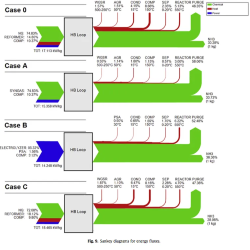Comparative studies of ammonia production, combining renewable hydrogen with Haber-Bosch
By Trevor Brown on February 02, 2017
In recent months, research teams from both Canada and Italy have published comparative analyses of sustainable ammonia production pathways.
These projects aim to quantify the costs and benefits of combining Haber-Bosch with a renewable hydrogen feedstock. Both projects examine the carbon intensity of ammonia production but, while the Canadian study broadens its remit to a full life cycle analysis, including global warming potential, human toxicity, and abiotic depletion, the Italian study focuses primarily on energy efficiency.
Comparative Life Cycle Assessment of Various Ammonia Production Methods
In Canada, the University of Ontario Institute of Technology and Hydrofuel Inc have produced a comparative life-cycle assessment of Haber-Bosch ammonia production using a feedstock of electrolytic hydrogen produced from a variety of power sources, including municipal waste, biomass, nuclear, and hydropower.
Among the paper’s conclusions:
• Ammonia production from biomass and municipal waste based water electrolysis provides a credible alternative for distributed ammonia production facilities and can enhance local fertilizer production capacity.
• Municipal waste based ammonia production have lowest abiotic depletion, global warming and human toxicity values among all other methods which can be evaluated as the most environmentally benign method.
• The renewable sources with their improved efficiency can reduce the overall environmental footprint and can replace the current fossil fuel based centralized ammonia production facilities.
Dincer, Vezina, et al: Comparative Life Cycle Assessment of Various Ammonia Production Methods, July 2016
This project builds upon another recent paper by the same team, which described a Comparative Life Cycle Assessment of NH3 as a Transportation Fuel in Ontario.
A system approach in energy evaluation of different renewable energies sources integration in ammonia production plants
The Italian study compared “efficiency, energy flows and greenhouse gas emissions” for Haber-Bosch ammonia synthesis using various hydrogen production pathways.

Their research examined three cases for renewable hydrogen production, including biomass gasification (Case A), electrolysis of water using solar or wind power (Case B), and biogas reforming (Case C), and compared these sustainable hydrogen sources against the traditional steam methane reformation of natural gas (Case 0).
According to the authors, the study “demonstrates that ammonia can be produced in an efficient way from renewable energy sources,” and “reveals the option of a distributed, efficient and sustainable ammonia production … that permits reducing of CO2 emissions and costs and increase the security of supply. In addition … such concepts permits to store renewable energy into an energy vector with high energy density and low emission.”
This paper makes an explicit case for the benefits of electrolytic hydrogen production, over biomass gasification or biogas reformation, as regards the energy flux of each system:
From the diagram it is possible to observe that the energy input of [Case B, which uses electrolytic hydrogen] is represented only by electricity and that the output is essentially the chemical energy associated to purge gas and ammonia …
This result confirm the profitability and the advantages associated to this layout because, globally, it is possible to conclude that the electric energy is quite completely converted, i.e. stored, into two type of useful chemicals, such as ammonia and the purge gas. In addition, due to the absence of high temperature treatments … the cooling requirements are low and also the heat losses …
In conclusion, the case B is the most convenient, not only from the chemical point of view, due to the high conversion efficiencies, and from the environmental one, due to the potential absence of GHG emissions, but also from the energy point of view because, among the renewable energy sources integration scenarios proposed in this work, it is the only layout that could allow the complete use and storage of electricity from renewables into energy vectors like hydrogen (in form of the purge gas) and ammonia.
Frattini et al: A system approach in energy evaluation of different renewable energies sources integration in ammonia production plants, July 2016
Interestingly, the study concludes that “Energy flows show that all the system[s, including traditional steam methane reformation,] have the same primary energy consumption in the order of 14-15 kW/kgNH3 with no impact of the new designs on the amount of primary energy used to produce NH3. This means that the introduction of renewable energy do[es] not limit the efficiency.”
Given this conclusion, it makes sense that the same team of Italian researchers have developed an “innovative” sustainable ammonia synthesis technology using electrolytic hydrogen, about which I write it my article on International R&D on sustainable ammonia synthesis technologies.
You can also read the full article at ammoniaindustry.com.